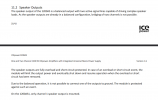I have two questions that would be great if they where covered here.
1. What is the consequences and limitations of the impedance/voltage settings.
2. How to measure power-amplifiers? Do this require a dummy load and in that case, how to build and connect it?
1. What is the consequences and limitations of the impedance/voltage settings.
2. How to measure power-amplifiers? Do this require a dummy load and in that case, how to build and connect it?

